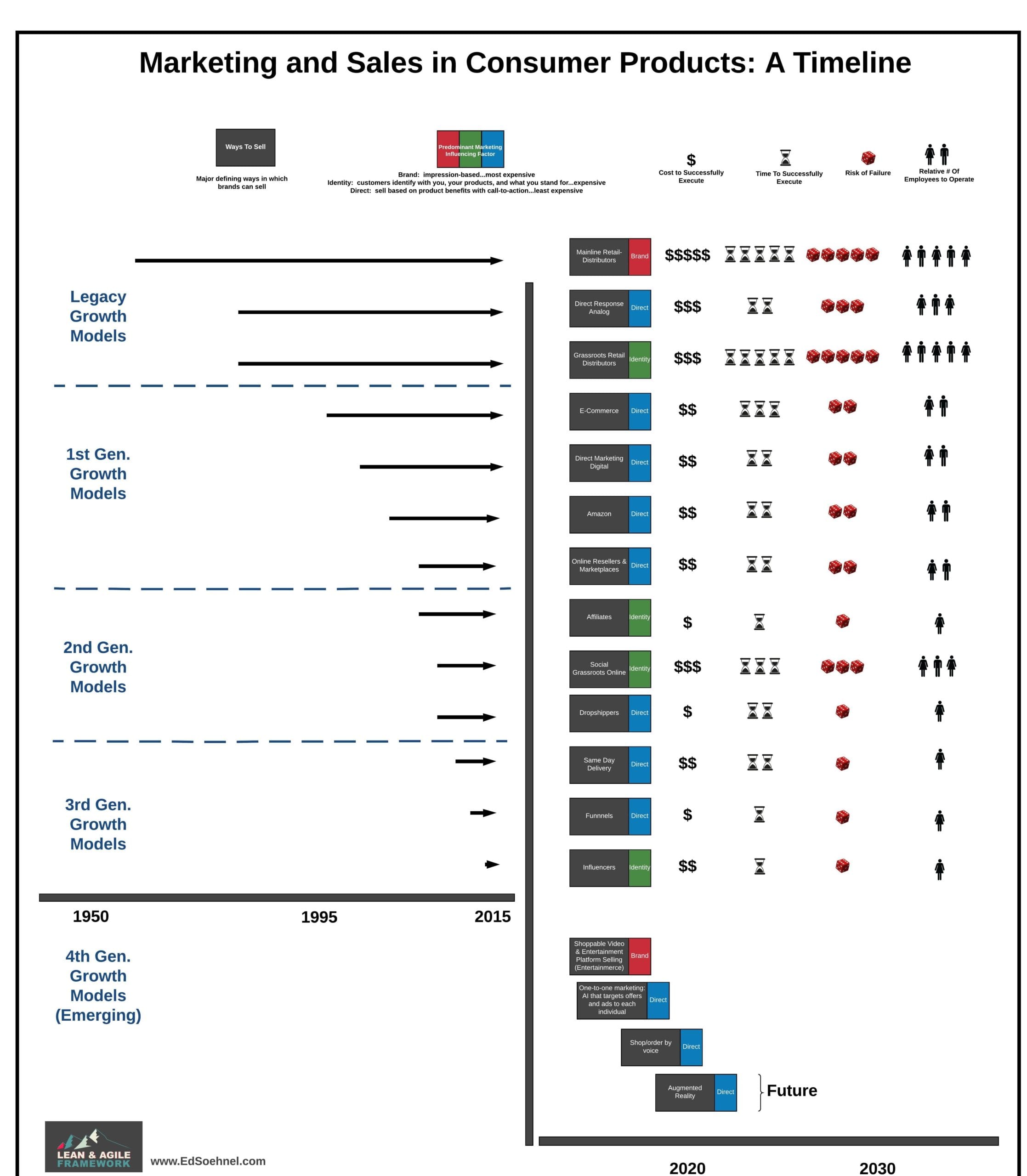This post provides a summary of consumer product growth strategies that I see, with their relative cost to successfully execute, time to successfully execute, risk of failure and manpower to execute.
Predominant marketing influencing factors
The three predominant marketing influencing factors are direct marketing (product centric), brand marketing (reputation centric), and grass roots (identity centric).
Direct marketing is you appeal directly to individual customers through advertising that has calls to action to purchase your product. In this method, you have to demonstrate the superiority of your product to get them to act. The customer may not know you so you have to sell them on your product. This method tends to be cheaper to use to generate sales and has immediate response so you know if it is working or not, but relies on a truly superior product that captures attention.
Brand marketing is you appeal indirectly to individual customers through advertising that emphasizes maximum impressions so that as your customers see your ads more and more, they will remember to purchase your product when they have a need. In this method, you are relying more on your reputation from previous products or advertising to get your consumers to purchase. This method tends to be more expensive to use to generate sales and also takes time before it works, so you do not know if it is working until time has passed to see if sales are generated.
Grassroots marketing is when you appeal directly to individual customers through advertising that emphasizes creating a connection with your customers based on what you stand for or what you are trying to do. In this method, customers identify with who you are and what you stand for, which causes them to want to support you by buying your products. This method tends to be more expensive to use to generate sales and also takes time before it works, so you do not know if it is working until time has passed to see if sales are generated.
Sales models
Here is a list of general high-level consumer product sales models to choose from.
Legacy growth models
Mainline retail distribution: develop, produce and sell a product through traditional brick and mortar retailers.
Direct response analog: develop, produce and sell a product through traditional direct response (TV, radio and print infomercials) with call center order fulfillment and direct to consumer shipping.
Grassroots retail distributors: develop, produce and sell a product through traditional small distributors to smaller retailers in fragmented channels.
1st generation growth models
E-commerce: develop, produce and sell a product through your online website/store.
Direct digital marketing: develop, produce and sell a product through online advertising.
Amazon: develop, produce and sell a product through Amazon’s marketplace.
Online resellers & marketplaces: develop, produce and sell a product through other online marketplaces.
2nd generation growth models
Affiliates: develop, produce and sell a product through online affiliates. Affiliates promote your product for you to their audience (website visitor, newsletter subscriber and social followers).
Social grassroots online: develop, produce and sell a product through social (getting likes, follows, etc).
Dropshippers: develop, produce and sell a product through dropshippers. Dropshippers are like affiliates, but instead, they setup their own storefronts and send the order to you for you to fulfill.
3rd generation growth models
Same-day delivery; develop, produce and sell a product through Amazon marketplace for same-day delivery.
Funnels: develop, produce and sell a product through sales funnel approaches. Funnels are a particular type of e-commerce cart that leads buyers through the sales and e-commerce process with value-added offers designed to ascend the buyer up a value chain.
Influencers: develop, produce and sell a product through influencers with email lists, social followers, or other mass appeal. This is similar to affiliates but influencers are more like celebrities or popular personalities that people follow for entertainment purposes, whereas affiliates tend to get followings due to some sort of utility they offer.
4th generation growth models
New growth models that appear to be emerging.
What I Use
My Lean & Agile Framework emphasizes direct marketing selling direct-to-consumer via shipping through more progressive methods listed that are cheaper to successfully execute, take less time to successfully execute, have lower risk of failure, with less headcount and overhead to operate, and offer higher profit margins over legacy models.
This is not to say that the more brand and grassroots centric approaches are not important; they may be, but later in a company’s stage of growth when there is proof of concept, recurring sales and cash flow to support these more expensive methods.
The Lean & Agile Framework is designed to let a company operate using any of the methods listed, except for future methods that are as yet to be developed. In this case, the Framework tries to anticipate what needs to be built into the company now to effectively operate and compete in environments that will have those future methods.





